|
Dog breeds of the world, Border collie |
Border Collie |
||
|---|---|---|
| Alternative names | ||
| Country of origin | ||
| United Kingdom | ||
| Common nicknames | ||
| Classification and breed standards | ||
| FCI: | Group 1 Section 1 #297 | |
| AKC: | Herding | |
| ANKC: | Group 5 (Working Dogs) | |
| KC (UK): | Pastoral | |
| NZKC: | Working | |
| UKC: | Herding Dog Breeds | |
| Not recognized by any major kennel club | ||
| This breed of Dog is extinct | ||
| Notes | ||
A Border Collie is a hard-working herding breed of Dog that originated in the border country of England and Scotland. Border Collies are highly intelligent herding Dogs. Like most working Dogs, they have a tendency towards neurotic or destructive behavior if not given enough to do. They are still frequently used on farms all over the world for assisting with the handling of livestock. Though known to be reserved with strangers, these Dogs can also be protective of a human family member and affectionate to those they know.
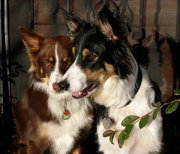 Border Collies commonly have red and white or black and white coats.
Border Collies commonly have red and white or black and white coats.
Because Border Collies have historically been selected for working ability, and not looks, they vary widely in appearance. In general, they are medium-sized Dogs without extreme physical characteristics and a moderate amount of coat. Their double coats can be anywhere from slick to lush, and can come in many colors, although black and white is by far the most often seen in the show ring and herding trials and therefore the most common in public perception; tricolor (black/tan/white) and red and white also occurs regularly, with other colors such as, blue and white, red merle, blue merle, or sable seen less frequently. Eye color varies from deep brown to amber or blue with occasionally one eye of each color. The ears of the Border Collie are also highly variable -- some have fully erect ears, some fully dropped and other are semi-erect (similar to that of the Rough Collie). Although working Border Collie handlers sometimes have superstitions about the appearance of their Dogs (many handlers do not prefer red Dogs, or mostly white Dogs), in general a Dog's appearance is considered to be irrelevant. It is much more useful to identify a working Border Collie by its attitude and ability, not its looks.
Those Dogs bred for the conformation ring are much more uniform in appearance than working Border Collies, since to be successful show Dogs they must conform to kennel club standards that are specific on many points of the anatomy and furnishings. Kennel clubs specify that the Border Collie must have a keen and intelligent expression; the preferred eye colour is generally brown. In deference to the Dog's working origin, scars and broken teeth received in the line of duty are not to be counted against a Border Collie in the show ring, although how many show collies actually work might be arguable.
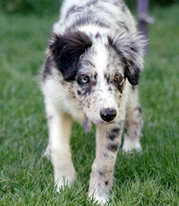 Blue
merle BC puppy at 14 weeks using herding eye (gaze and lowered
stance); this Dog's
eyes
are different colors, which is not uncommon in merles.
Blue
merle BC puppy at 14 weeks using herding eye (gaze and lowered
stance); this Dog's
eyes
are different colors, which is not uncommon in merles.
Border Collies are extremely energetic and require a lot of attention. They are better off in a household that can provide them with plenty of exercise and a job to do. Like most herding breeds, they will attempt to herd family members, cats, squirrels, bicycles, cars, or anything else that moves in the absence of other charges. Border Collies make bad pets for people who cannot provide a considerable amount of daily exercise, both physical and mental. Many Border Collies end up in shelters or rescue groups because families, attracted by their appearance, discover that they cannot provide the attention and effort required for this driven, active, easily bored breed?though this problem can be alleviated by giving the Dog lots of mental and physical stimulation. This can be done by taking them to training classes and for long, brisk walks. Participating in Dog sports such as Dog agility, flyball, sheepDog trials, Dog sledding races and obedience are also popular with Border Collie owners for this reason. It may also help to have more than one Dog; with Border Terriers and other Collies the most ideal companions. Among some breeders of the breed in Britain, there is a common saying: "no sheep, no collie", referring to the Dog's usual unsuitability to people who just want a "smart Dog". Border Collies love to play and do not always know when to stop on their own; owners must ensure that they do not overexert themselves, especially in hot weather, which can be dangerous.
Hip dysplasia is widespread among purebred Border Collies. Elbow dysplasia also occurs, along with epilepsy and hypothyroidism. Dogs homozygous for the merle gene are likely to have eye and/or hearing problems. Collie eye anomaly (CEA) can now be tested for genetically. Some Border Collie breed clubs are active in promoting research into hereditary diseases of this breed.
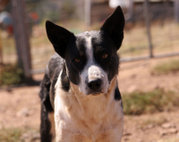 A smooth-coated Border Collie cross
A smooth-coated Border Collie cross
As is the case with many breeds of Dogs that are still used for their original purposes, breed standards vary depending on whether the registry is more interested in a Dog that performs its job superbly or a Dog whose appearance meets an ideal standard.
There are two types of tests, or standards, to determine the breeding quality of a Border collie. The original test was the ISDS sheepDog trial, where a Dog and handler collect groups of livestock and move them quietly around a course. The 'standard' comes from the fact that, the world over, there are certain standard elements to this test. Sheep must be gathered without being too much disturbed, from a distance farther than the typical small airport runway. They then must be directed through obstacles at varying distance from the handler, and then the Dog must demonstrate the ability to do work close at hand by penning the sheep and sorting them out. It is these elements which have shaped the working abilities of the Border collie and defined the breed until very recently. These Dogs are necessarily capable of incredible feats of athleticism, endurance, intense focus, and high levels of trainability.
In nearly every region of the world, the Border collie is now also a breed which is shown in ring or bench shows. For the people who participate in these events, the Border collie is defined by the breed standard, which is a description of how the Dog should look. In New Zealand and Australia, where the breed has been shown the longest, the Border collie standards have produced a Dog with a long double coat (smooth coats are not allowed), a soft dark eye, a body slightly longer than square, a well-defined stop, and a gentle and friendly expression. This style of Border collie has become quite popular in winning show kennels around the world, as well as among prestigious judges, so it is to be expected that this type will soon predominate even in countries like the US where the native lines are very different.
It is possible (although unlikely) for a Dog to do both, but a working Dog's options for competition in Dog shows might be limited depending on its ancestry and on the opinions of the various kennel clubs or breed clubs involved, and most handlers of working Border Collies are uninterested in participating in Dog shows. Conformation-bred Dogs are seldom if ever seen on the sheepDog trial field.
In the UK, there are two separate registries for Border Collies. International Sheep Dog Society [1] and other similar organizations encourage breeding for herding ability, whereas the Kennel Club (UK) encourages breeding for a specific appearance.
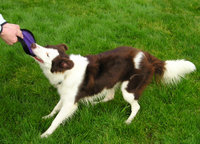 Red and white Border Collie playing a favorite game
Red and white Border Collie playing a favorite game
In the United States, the vast majority of Border Collies are registered with the American Border Collie association, which is dedicated to the preservation of the working Dog. However, the breed was also recognized in 1995 by the American Kennel Club, which promotes standards based on appearance and promotes registration of Dogs whose parents were registered. The recognition was under protest[2] from the majority of Border Collie-affiliated groups, such as the United States Border Collie Club, that felt that emphasis on the breed's working skills would be lost under AKC recognition.
Some people believe that the emphasis placed on appearance might ruin the breed for its traditional livestock work because breeding for appearance eliminates emphasis on intelligence and working ability. Others believe that, in today's world, where livestock work is uncommon, the beauty of the breed is the factor that should be preserved.
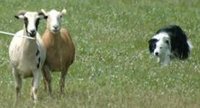 Freya fetching at a sheep Dog trial.
Freya fetching at a sheep Dog trial.
The many people who depend on the breed for their livelihood in managing livestock know that Border collies bred strictly to work are the best representatives of the original premier livestock working breed. Breeding for "beauty contests" has long been understood to water down this ability.
However, most people who own Border Collies as pets and also compete with them in the wide variety of Dog sports available to them prefer to have Border Collies who come from working lines, not show lines, because the intelligence, drive, and athleticism are preserved over a lush coat or standard size and weight. The future shape of this breed is still very much in question and is largely dependant on whether working breeders will accept being marginalized or whether they can educate people to appreciate the breed for what it really is, a premier livestock working Dog.
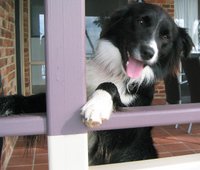 Black and white Border Collie - working Dog or family pet all have a great
temperament
Black and white Border Collie - working Dog or family pet all have a great
temperament
These collies can take direction by voice and whistle at long distances when herding. Their great energy and herding instinct are still used to herd all kinds of animals, from the traditional sheep and cattle, free range poultry, and pigs, to deer and ostriches. They are also used to remove unwanted wild birds from airport runways, golf courses, and other public and private areas.
Border Collie competitions may involve actual herding or simulated tasks. Shepherds in Britain have taken the most critical elements of herding and designed a sheepDog competition. Originally farmers used such competitions to evaluate possible mates for their working Dogs, but they have now developed into a true sport with many competitors from outside the farming community taking part. In the US, the national body for these competitions is the USBCHA[3]. In Britain it is the International SheepDog Society, and in Canada the CBCA[4].
Because of their working background, Border Collies excel at several Dog sports. They dominate the higher jump heights at Dog agility competitions, so much so that in England the Border Collies occasionally are given competitions separate from all other breeds.